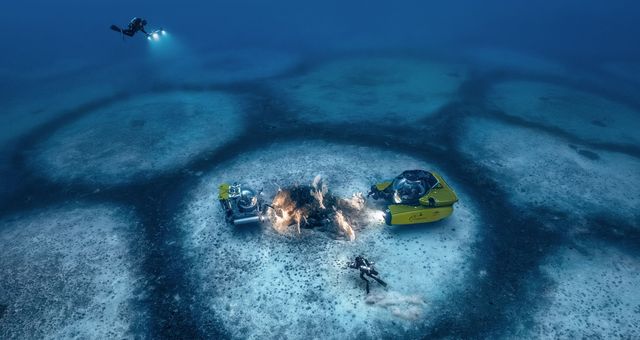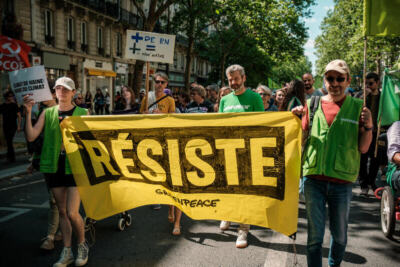Three years of investigation, off the coast of Cap Corse, led by Laurent Ballesta’s team, have helped solve the enigma of these rings. Circular, regular shapes at 120 meters depth, remnants on a desert of sand, yet harboring life – what is the mystery behind these rings?
With Laurent Ballesta, marine biologist
Off the coast of Cap Corse, 20 kilometers from the shore, where the sea becomes a continent of deep, silent water, there exists a valley whose existence no one suspected.
It is an underwater plain, swept by currents, covered in sand and shadows, yet marked by a strange mystery. This secret was revealed by chance in 2011. On that day, the cold eye of a sonar scanned the seabed as part of a simple mapping mission. But what it returned on the screens was unlike anything known. A pattern. Then another. Then hundreds. Circles. Perfect. Inexplicable. Aligned, arranged like on a musical score, these 1,417 rings form a geometric landscape as far as the eye can see. Each one measures nearly twenty meters in diameter, all resting at over one hundred meters depth.
Each circle seems to have been drawn by hand, dug into the sand like a ritual imprint. Some harbor life – fish, corals, creatures adapted to the darkness. This valley is a refuge and a sanctuary. Others appear to have been frozen for centuries. But all of them tell a story. Something ancient. Something forgotten. It is the beginning of a grand investigation. Scientists observe and question. Is it the work of an animal? A current? A scar from a war? Then, one day, scientists decide to dive deeper into the mystery. An expedition is organized to venture into the unknown. Those who dare to explore will discover a world apart. What the samples revealed was completely unexpected…
This is the story that La Terre au carré tells in this show, with guest Laurent Ballesta, marine biologist and underwater photographer. He is the author of the documentary Cap Corse – The Mystery of the Rings, available on the platform arte.fr until August 2, 2027, and broadcast on Arte on Saturday, May 3, 2025.
What do these rings look like?
The biologist describes it, he has seen it: « We are talking about dark circles spread across a clear sand beach. » His first impression when the first human dive was done, ten years after their discovery by sonar, was that it wasn’t natural. Positioned 20 meters above them to observe, he had to collect his thoughts before analyzing the situation scientifically.
This discovery was made during a mapping mission, with possibly a hint, « in a geology thesis by a student from Corte, the guy had also used sonar with cameras from his boat and had talked about ‘strange islets of life that deserved a closer look' ». There are now 1,600 rings, the number keeps growing as the observation work continues, with 1,300 that truly correspond to the first description, then other categories with slight variations. It is very striking to think that this was only discovered in 2011, on well-known French coasts, at just 100 meters depth. It’s the magic of the seabed, and also the fact that underwater expeditions are expensive.
Une station bathyale pour rester plus longtemps au fond
On se dit que 100 mètres, ce n’est pas grand-chose, certains courent cela en moins de 10 seconde, mais en profondeur d’eau, il faut six heures aux plongeurs pour remonter. La première plongée en juillet 2020 a duré 27 minutes, « il m’a fallu plus de cinq heures pour remonter » témoigne le biologiste ; afin de laisse le gaz des bouteilles sortir de l’organisme. « Il faut juste être patient, parfois endurant, car c’est parfois pénible quand il fait un peu froid.«
Alors quitte à rester longtemps dans ces eaux, autant en profiter ; l’idée a donc été de construire une base sur le fond marin. Quatres personne sont ainsi restées dans 25 mètres carrés, pendant 21 jours de vie, dans une capsule pressurisée à 120 mètres de profondeur. Petit inconvénient, la voix y est totalement déformée, « entre nous, on ne peut pas se parler sauf à mettre un casque avec un ordinateur qui retimbre« . Donc très vite l’équipe arrête de parler, car « c’est pénible« , la communication se fait alors par des signes, par des sourires. « On a beaucoup souri. » On entend dans cette émission une version où la voix n’est pas refaite, une espèce de canard qui émettrait des onomatopées, étonnant.
Percer le mystère des ronds du Cap Corse
Seraient-ce des trous de bombe ? Impossible, car il ne s’agit pas de trous, mais de buttes, et puis, recouvertes de 21 000 ans de sédiments, ces bombes auraient été jetées par Cro-Magnon. Impossible.
Seraient-ce des sorties de gaz ou d’eau douce, qui auraient donné ces constructions géologiques ? La chose doit être vérifiée…
Le biologiste Laurent Ballesta explique que « c’est un formidable concours de circonstances, il a fallu toute une série d’événements qui se passent au même endroit pour qu’on arrive à ces vestiges-là aujourd’hui. » Il y a même sur zone des espèces que le biologiste n’avait jamais vu, comme des coraux, des gorgones, des limaces de mer, ou encore des étoiles de mer. « Heureusement qu’il y avait ces récompenses naturalistes, car les plongées étaient assez ingrates à ces profondeurs-là.«
Pour l’anecdote, un lien a été établi entre les fonds marins et l’espace lorsque Thomas Pesquet se trouvait dans la station spatiale. Laurent Ballesta s’étonne encore de la curiosité de l’astronaute pour la vie des plongeurs dans leur capsule. Il viendra plusieurs mois après voir ces anneaux avec le biologiste grâce à un sous-marin, tout ne s’est pas déroulé comme prévu… Le biologiste raconte cette autre aventure dans l’émission.
Source: radiofrance



